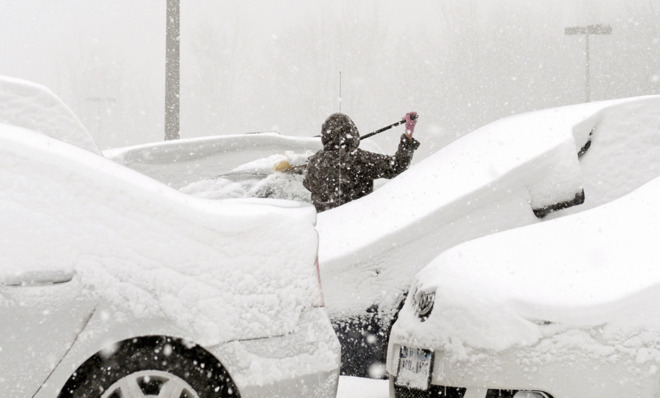Did December's cold snap freeze hiring?
123,000 more workers than usual were out of work due to cold weather last month. That's the exact difference between today's jobs numbers and Wall Street's prediction.

The December jobs report is out, and the headline is that far fewer jobs were created than people were expecting. The number of payrolls increased just 74,000 compared to Wall Street's consensus of 197,000, and far below November's job-creation figure, which was revised up to 241,000 from a previous estimate of 203,000.
Yet unemployment fell to just 6.7 percent, down from seven percent last month, suggesting that there was a strong improvement in the proportion of people looking for work who found it.
Why is unemployment so upbeat and job creation so downbeat? December was a freak month for payrolls — the fact that there was any job creation at all is impressive. So I think that any worries that the recovery has been hugely derailed need to wait. Why? Because of the weather.
The Week
Escape your echo chamber. Get the facts behind the news, plus analysis from multiple perspectives.

Sign up for The Week's Free Newsletters
From our morning news briefing to a weekly Good News Newsletter, get the best of The Week delivered directly to your inbox.
From our morning news briefing to a weekly Good News Newsletter, get the best of The Week delivered directly to your inbox.
While 535,000 people — for various reasons, including retirement — left the labor force last month, 273,000 of those weren’t at work because of the cold weather. If employees didn’t receive compensation for the entire pay period that included the 12th of the month, they’re not included in payroll numbers. This detail is hugely important.
Last month was the coldest December since 2009 and snowfall was 21 percent above normal. The second week of December was the coldest for any comparable period in more than 50 years, significantly raising the number of people who have jobs, but who weren’t counted in payrolls for December. Of course, the BLS is supposed to adjust for winter through its "seasonal adjustment" of the jobs data, but it bases that algorithm on recent history. 273,000 out of work due to the cold weather is vastly more workers out of work than last year. It's also vastly more than any other year in the past 10 years, which have averaged around 150,000. A basic, back-of-the-envelope calculation shows how incredibly important this is: That extra 123,000 workers out of work due to the cold weather is the exact difference between the number of new jobs (74,000) the BLS reported today and Wall Street's prediction (197,000).
So when all the people who weren’t working because of the cold weather are added back into the labor force, the job numbers that month will look better.
That may not be next month, though. With weather also highly inclement around the country this month, the January job creation figures may also look quite bad too. We may have to wait for a month of better weather to get a better clue to the real state of the economy, and whether or not the Federal Reserve’s decisions to taper asset purchases down to $75 billion from $85 billion was smart or misguided.
A free daily email with the biggest news stories of the day – and the best features from TheWeek.com
John Aziz is the economics and business correspondent at TheWeek.com. He is also an associate editor at Pieria.co.uk. Previously his work has appeared on Business Insider, Zero Hedge, and Noahpinion.
-
 Zimbabwe’s driving crisis
Zimbabwe’s driving crisisUnder the Radar Southern African nation is experiencing a ‘public health disaster’ with one of the highest road fatality rates in the world
-
 The Mint’s 250th anniversary coins face a whitewashing controversy
The Mint’s 250th anniversary coins face a whitewashing controversyThe Explainer The designs omitted several notable moments for civil rights and women’s rights
-
 ‘If regulators nix the rail merger, supply chain inefficiency will persist’
‘If regulators nix the rail merger, supply chain inefficiency will persist’Instant Opinion Opinion, comment and editorials of the day